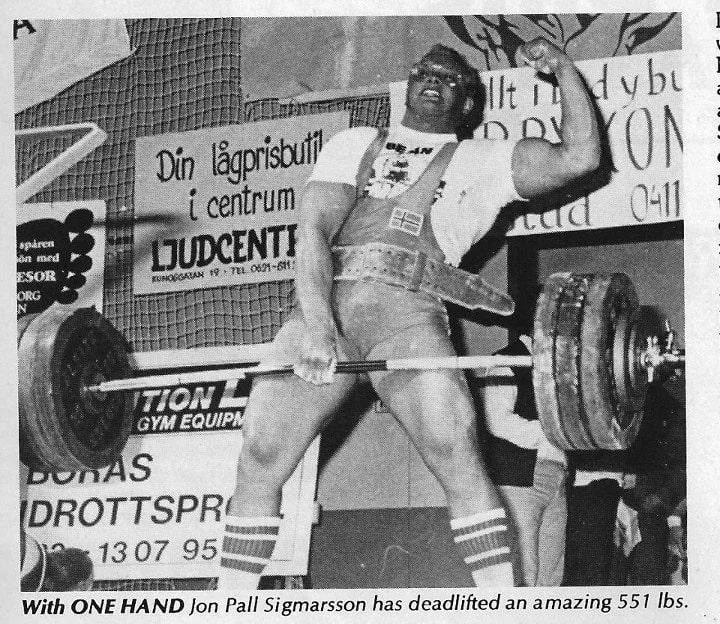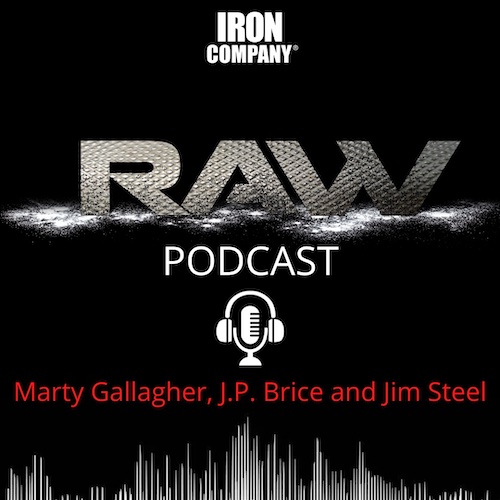
Sustained Strength Mastery
Sustained Strength Mastery is the key to attaining stamina, vitality, leanness, heart health, and vibrancy
Sustained strength master Jon Pall Sigmarsson (above) demonstrates his absolute strength credentials as he pulls 250 kilos, 551-pounds, with one hand. He has the time and presence of mind to hit a bicep pose with his unused left arm. I heard he had pilled on 275K (606-pounds) using one arm and his fearsome hook grip.
Whenever the discussion of strength arises, the first question should be, what kind of strength? Which type of strength? There are three definable strength types: absolute strength, explosive strength, sustained strength. Briefly: absolute strength, including isometric and isotonic strength, is best exemplified by an elite powerlifter moving massive poundage for short distances with no regard for velocity. Explosive strength is best exemplified by the Olympic weightlifter pulling a moderate (relatively) payload over an extended range-of-motion using maximum velocity. Sustained strength, or strength endurance, is the purposeful inclusion of repeated muscular contractions into a cardiovascular format. Sustained strength examples might include extended kettlebell drills, wrestling, high impact rugby, or MMA drills. The commonplace mistake is to fuzz the distinctions between the three types, or champion one strength type to the exclusion of the other two. Optimally, ideally, each of the three strength types receives its fair share of attention.
Sustained strength, the intersection of strength training and cardiovascular exercise: Sustained strength is (as the name implies) the ability to generate a significant amount of available power for extended periods without “gassing out.” This ability to go harder longer without succumbing to oxygen debt is developed over time with repeated practice. There are a limitless number of sustained strength modes and methods. The sustained strength commonality is the invocation of repeated muscular exertions over extended periods. When dealing with the realities of sustained strength training, the twin eternal variables are intensity (how hard) and duration (how long.) These two variables have an inverse relationship: dramatically increase intensity and duration shrinks. Dramatically increase duration and intensity must necessarily lessen. When seeking to increase sustained strength, continually bias these two variables to create contrast. i.e., go shorter and more intense, or lengthen the drill or session, dialing back the intensity. The following are valid sustained strength modes of varying durations.
| MODE | DURATION | INTENSITY |
| Kettlebell Snatch Drill | 20-minutes | 54-pound kettlebell, 10-rep sets, both arms |
| Wrestling | 30-minutes | Rotate in fresh opponent every 5-minutes |
| Hill Running | 45-minutes | 100-meter incline, jog down |
| Bodybuilding | 60-minutes | 40 cumulative sets, forced reps, drop sets |
| Rugby Game | 80-minutes | Non-stop exertions interspersed with collisions |
Bill Pearl; bodybuilding as a sustained strength mode: Bodybuilding legend Bill Pearl once related to me that he did not engage in formal cardiovascular training because during his six-day-a-week, 120-minute training sessions, his heart rate never dropped below 120 and repeatedly spiked to 180 + in the aftermath of grueling, high rep sets. He made the salient point, “Marty, does the heart really care how it gets elevated? As long as it gets elevated – does the heart care how?” Pearl’s two-hour training sessions famously ran from 4:30 to 6:30 Monday thru Saturday. Bill hit every muscle three times a week and would work through 80 + sets in a session. This is an irrefutable sustained strength mode. Bill sacrificed poundage for volume and pace. He would rotate performing the same exercise with training partners, one goes, then the next, and the next – add weight repeat, never pause.
King Kaz shifts with the times: Bill Kazmaier came into the Strongman game as a world champion powerlifter with a world record bench press and deadlift. In the earliest days, when ABC Wide World of Sports ran their annual World’s Strongest Man competition, there were a wide range of events that favored the single-rep powerlifter. In one memorable episode, the squat lift, Kaz dropped a platform full of Playboy Bunnies so hard (after posting the winning single rep squat) the impact caused one voluptuous Bunny to lose her top, to the delight of every onlooker and the horror of ABC. The winds shifted away from single-rep events into sustained strength extended events. Kaz shifted his training and would run stadium steps wearing a 50-pound vest while pumping two 40-pound dumbbells: his heart rate would soar to 200-beats per minute.
Steve Justa, sustained strength OG: Before anyone else, Iron Savant Steve Justa grokked the need for, and significance of, strength endurance. Justa created a sustained strength training method decades ahead of its time. Steve lived on a farm in Nebraska. “Once at a seminar I saw a famous lifter do eight reps with 505-pounds in the bench press. Thirty minutes later he is still huffing and puffing from the 505x8. Now how much good is strength like that?” This set Justa on an incredible journey of self-discovery wherein he used himself as his laboratory. “I have walked a quarter mile with a 500-pound barbell on my back. I have carried a 350-pound rock for two city blocks. I worked in a hide house throwing 100-pound cow hides all of one summer.” Steve created a 100-pound chain mail vest. “I wore it to work for a month. I scooped grain 12-hours a day.” His “Attack Plan” is priceless.
Mark Coleman overcomes “gassing out”: Mark “The Hammer” Coleman is a UFC hall-of-fame fighter. Early in his MMA career, and despite being an international level wrestler, Mark would exhaust himself trying to overcome an opponent. Having burned every ounce of energy, his blood sugar would plummet to the point he was unable to raise his arms. His solution was to “spend a lot less time on the stationary bike and a lot more time running steep hills.” Coleman related that he “didn’t feel right” unless “I puked at the conclusion of the hill running session.” Another Coleman sustained-strength enhancer was to head to the Ohio State wrestling room and proceed to wrestle 30-straight minutes, rotating in a fresh opponent every five minutes. Mixed martial artists have been at the forefront when it comes to devising sustained-strength drills.
Integrating sustained strength into the transformative template: The sophisticated athlete seeks continual improvement and to that end, apportions a percentage of available training time to strength training and a certain portion of available training time to cardiovascular exercise. One seamless way in which to incorporate strength-endurance into the training template is to have sustained strength drills double as cardiovascular exercise. While absolute strength training is best done infrequently, cardiovascular exercise is optimally done often. Rather than jog, ride a stationary bike, or engage in classical ‘steady-state’ cardio, why not substitute ‘burst’ or ‘interval’ cardio and sprint, run hills, practice jujitsu, engage MMA drills or perform an extended kettlebell session? This strategy, melding sustained strength and cardio, is logical and kills two proverbial birds with one stone.
About the Author - Marty Gallagher
As an athlete Marty Gallagher is a national and world champion in Olympic lifting and powerlifting. He was a world champion team coach in 1991 and coached Black's Gym to five national team titles. He's also coached some of the strongest men on the planet including Kirk Karwoski when he completed his world record 1,003 lb. squat. Today he teaches the US Secret Service and Tier 1 Spec Ops on how to maximize their strength in minimal time. As a writer since 1978 he’s written for Powerlifting USA, Milo, Flex Magazine, Muscle & Fitness, Prime Fitness, Washington Post, Dragon Door and now IRON COMPANY. He’s also the author of multiple books including Purposeful Primitive, Strong Medicine, Ed Coan’s book “Coan, The Man, the Myth, the Method" and numerous others. Read the Marty Gallagher Biography for a more in depth look at his credentials as an athlete, coach and writer.



